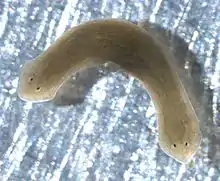| Dugesia japonica | |
|---|---|
 | |
| Two headed D. japonica that regenerated from a trunk fragment exposed to Praziquantel.[1] | |
| Scientific classification | |
| Domain: | Eukaryota |
| Kingdom: | Animalia |
| Phylum: | Platyhelminthes |
| Order: | Tricladida |
| Family: | Dugesiidae |
| Genus: | Dugesia |
| Species: | D. japonica |
| Binomial name | |
| Dugesia japonica Ichikawa & Kawakatsu, 1964 | |
Dugesia japonica is a species of freshwater planarian that inhabits freshwater bodies of East Asia, including Japan, Korea, Taiwan, China and northeastern Siberia.[2] However, molecular studies suggest that Dugesia japonica is polyphyletic and different populations across its area of occurrence constitute distinct species.[3]
Phylogeny
D. japonica position in relation with other Dugesia species after the work of Lázaro et al., 2009:[4]
| Dugesia |
| ||||||||||||||||||||||||||||||||||||||||||||||||||||||||||||||||||||||||
Space Experimentation
A study was published in 2017 in which a Dugesia Japonica trunk fragment had been sent into space, and grew with two heads, one on either end of the trunk.[5] However, the influence of space conditions on this phenomenon is debated.[6]
References
Wikispecies has information related to Dugesia japonica.
- ↑ Nogi T, Zhang D, Chan JD, Marchant JS (June 2009). Keiser J (ed.). "A novel biological activity of praziquantel requiring voltage-operated Ca2+ channel beta subunits: subversion of flatworm regenerative polarity". PLOS Neglected Tropical Diseases. 3 (6): e464. doi:10.1371/journal.pntd.0000464. PMC 2694594. PMID 19554083.
- ↑ Kawakatsu, Masaharu; Oki, Iwashiro; Tamura, Sachiko (June 1995). "Taxonomy and geographical distribution of Dugesia japonica and D. ryukyuensis in the Far East". Hydrobiologia. 305 (1–3): 55–61. doi:10.1007/BF00036363. eISSN 1573-5117. ISSN 0018-8158.
- ↑ Solà, Eduard; Leria, Laia; Stocchino, Giacinta Angela; Bagherzadeh, Reza; Balke, Michael; Daniels, Savel R.; Harrath, Abdel Halim; Khang, Tsung Fei; Krailas, Duangduen; Kumar, Biju; Li, Mei‐Hui; Maghsoudlou, Abdolvahab; Matsumoto, Midori; Naser, Niamul; Oben, Benedicta; Segev, Ori; Thielicke, Matthias; Tong, Xiaoli; Zivanovic, Goran; Manconi, Renata; Baguñà, Jaume; Riutort, Marta (19 May 2022). "Three dispersal routes out of Africa: A puzzling biogeographical history in freshwater planarians". Journal of Biogeography. 49 (7): 1219–1233. doi:10.1111/jbi.14371. eISSN 1365-2699. hdl:2445/193751. ISSN 0305-0270.
- ↑ Lázaro EM, Sluys R, Pala M, Stocchino GA, Baguñà J, Riutort M (September 2009). "Molecular barcoding and phylogeography of sexual and asexual freshwater planarians of the genus Dugesia in the Western Mediterranean (Platyhelminthes, Tricladida, Dugesiidae)". Molecular Phylogenetics and Evolution. 52 (3): 835–45. doi:10.1016/j.ympev.2009.04.022. PMID 19435604.
- ↑ Morokuma J, Durant F, Williams KB, Finkelstein JM, Blackiston DJ, Clements T, et al. (April 2017). "Planarian regeneration in space: Persistent anatomical, behavioral, and bacteriological changes induced by space travel". Regeneration. 4 (2): 85–102. doi:10.1002/reg2.79. PMC 5469732. PMID 28616247.
- ↑ Sluys R, Stocchino GA (August 2017). "Bipolarity in planarians is not induced by space travel". Regeneration. 4 (4): 153–155. doi:10.1002/reg2.90. PMC 5743782. PMID 29299320.
This article is issued from Wikipedia. The text is licensed under Creative Commons - Attribution - Sharealike. Additional terms may apply for the media files.
